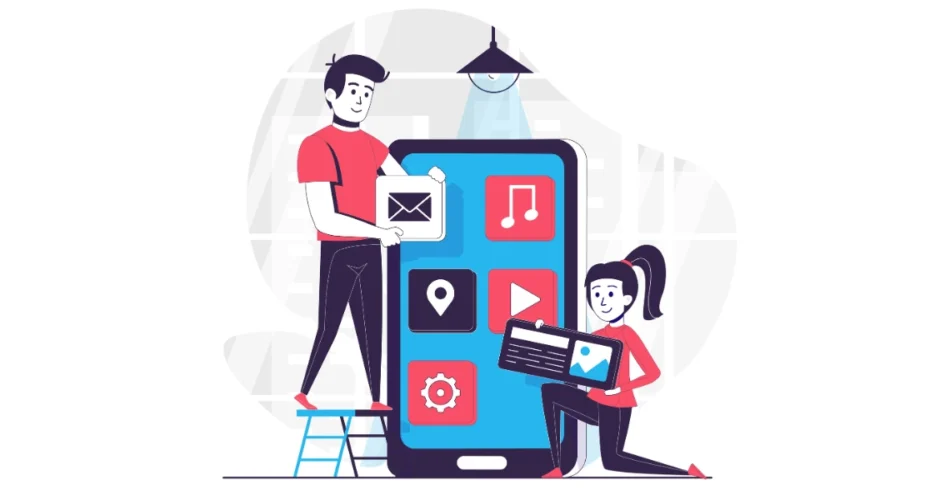You are either an app developer or a marketer. And you have an amazing app. It could be for entertainment, shopping, or learning purpose.
So you want to increase its downloads. But the question is—how?
Enter App Store QR Code.
Let’s find out more about how QR Code to an app store works and more!
A. What is an App Store QR Code
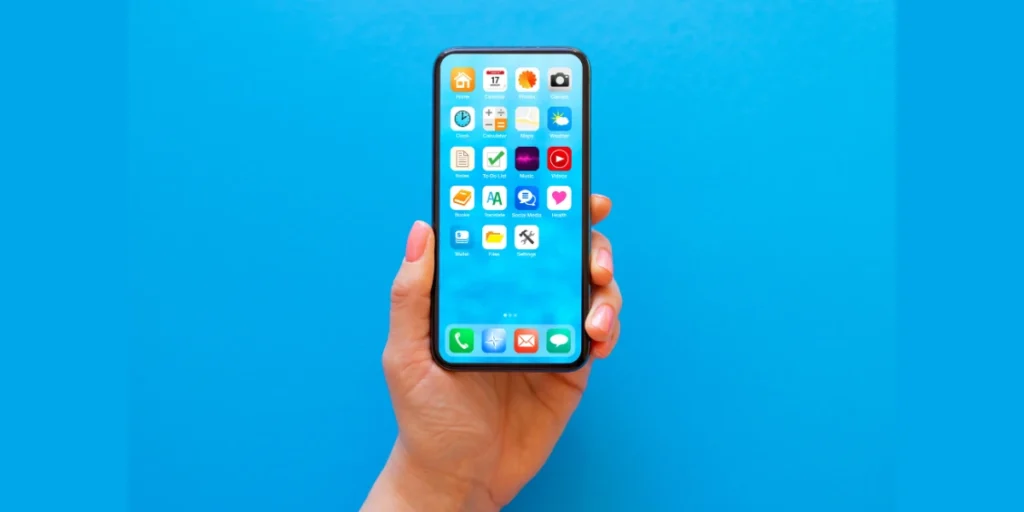
An App Store QR Code is a two-dimensional barcode. When scanned with a compatible mobile device, it typically directs the user to download or access a specific mobile application.
Here’s how it works:
1. Content
The QR Code contains specific information or a URL that links to the app’s download page on the respective app store. It could be the Apple App Store for iOS or the Google Play Store for Android. This URL might be a deep link, a website URL, or a combination.
2. Scanning
Users can scan the QR Code using the camera on their smartphones or a QR Code scanner app. Many smartphones now have built-in QR Code scanning capabilities.
3. Action
After scanning the app store QR Code, users are usually presented with the option to open the link. It takes them directly to the app’s page on the app store. From there, they can download and install the app.
App store QR Codes are commonly used in marketing and advertising materials. This makes it convenient for potential users to quickly access and download an app. This is especially useful for businesses, organizations, or individuals looking to promote their mobile applications.
When creating an app store QR Code for your app, it’s essential to ensure that the linked URL is accurate, up-to-date. It should correctly direct users to the appropriate app store for their device. Customization options, like adding your app’s logo or branding, can help make your QR Code more visually appealing and consistent with your app’s design.
B. How does an App Store QR Code work
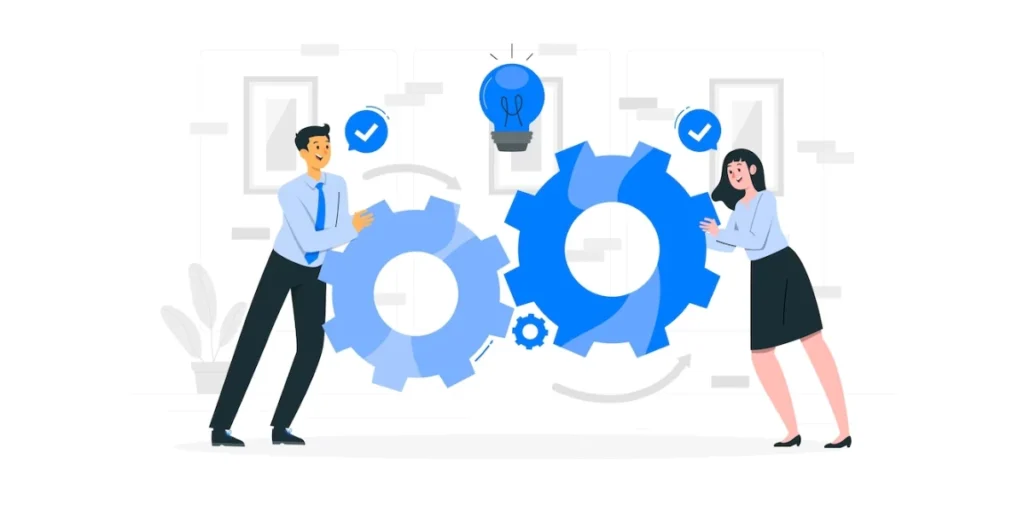
App Store QR Codes are powered by the underlying technology of QRs and the infrastructure of the respective app stores. Here’s a breakdown of the key components:
1. QR Codes technology
- QR Code format: QR Codes are two-dimensional barcodes that can store various types of information, such as text, URLs, or other data.
- Data Encoding: QRs can encode data using different schemes, including alphanumeric, binary, or numeric.
2. App Store integration
- Linking to App Store content: App Store QRs typically contain a link to a specific app’s page on the respective app store (e.g., Apple App Store, Google Play Store). This link directs users to the app’s details, reviews, and the option to download and install the app.
- App identification: The QR includes information that identifies the app uniquely, ensuring users are directed to the correct app page.
3. App Store infrastructure
- App Store servers: The app store infrastructure handles the processing of QR requests. When a user scans the QR, the app store servers process the request and provide the user with the relevant app information.
- Authentication and authorization: The app store infrastructure ensures that the user has the necessary authentication and authorization to access the app details and initiate the download.
4. Mobile device compatibility
- QR Code reader: The user’s mobile device must have a QR reader app or a built-in QR scanning feature. Users can use their device’s camera to scan the QR, which then interprets the encoded data and takes appropriate action, such as opening the App Store page.
5. App Store APIs
- Application Programming Interfaces (APIs): App stores provide APIs that allow developers and third-party services to interact with their platforms. QR scanning can involve calling these APIs to retrieve information about the app or initiate the download process.
C. How to increase app downloads

To do it, you will definitely follow some basic best practices. For example—having a simple app name, using an attractive icon, and ensuring good ASO (App Store Optimization).
But besides these, what you can also do is—promote your app via print promotions. Why print?
Of course, you can use digital promotions to do the job. But the problem is—people see multiple digital ads every day. But they do not remember most of them. That means—the attention span of digital ads is less.
On the other hand, you do not come across as many print ads every day. And it is a fact that print media has a longer attention span than that of digital media. Let’s see in what ways can you promote your app via print media promotions.
Learn all about making QR Codes in this ultimate guide.
1. Using your app link or name
This is the most obvious and common way to promote your app. Just mention its name or the AppStore link on your promotional material (flyers, brochures, banners, etc.).
And add an instruction (call-to-action statement) such as—Visit the link to download the app.
But the problem is—to download your app here, users will have to open the browser/app store on their phones, type the app name/link, find the app, and finally download it.
This is a long and tedious process. And to be honest, while some people might do it, others won’t.
So what you can do here is—make it easier for them to take action.
2. Using actionable QR Codes for different app stores
You know what a QR Code is. It is a 2D barcode that, when scanned, takes the end-users to see the encoded information.
You can create a QR Code that takes people to your app after which they just need to install it.
But say you have your app available on different app stores such as both Apple App Store and Google Play Store. Here, you’d want the end-users to be redirected to the relevant app stores as per their mobile’s operating system.
In such cases, you’ll have to create a separate QR Code for each app store.
Now that will take a lot of space on your promotional material. That means a lot of clutter. But don’t worry. You can easily cut on the clutter. Keep reading to know how.
3. Using a single QR Code for all app links
Rather than creating an individual QR Code for each app store, you can create a single QR Code for all app links.
When end-users scan it, it redirects them to the appropriate app store. That’s how simple it is. We call it—an App Store QR Code.
D. What is app deep linking
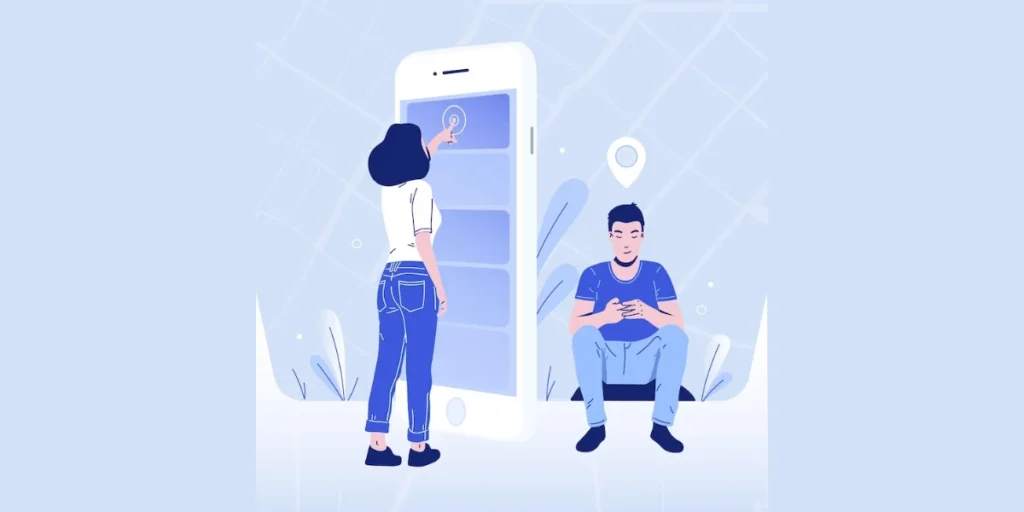
App deep linking refers to a technology that allows you to link to specific pages or content within a mobile application, rather than simply launching the app’s home screen.
It enables a seamless transition from an external source, such as a website, email, or another app, directly to a particular location or page within a mobile app.
Here’s how app deep linking works and why it’s beneficial:
1. Enhanced user experience
Deep linking improves the user experience by providing a seamless transition from one platform or app to another. This ensures users land directly on the relevant content they expect to see.
2. Cross-platform integration
Deep linking can bridge the gap between the web and mobile apps. This provides a unified experience for users across different platforms.
3. Personalized marketing
With deep linking, you can create personalized user experiences by directing users to specific content, promotions, or personalized recommendations within your app.
4. Improved conversion rates
By guiding users directly to relevant content or products within your app, deep linking can improve conversion rates and encourage users to take specific actions.
5. Tracking and analytics
Deep linking allows you to track user engagement. Also, you can monitor the effectiveness of marketing campaigns, and gain insights into user behavior within the app.
6. Retargeting and re-engagement
Deep linking facilitates retargeting and re-engagement efforts. This helps direct users back to specific pages or sections of your app, encouraging continued interaction and usage.
7. Seamless onboarding
Deep links can be used for seamless onboarding. It helps guide new users to specific introductory screens or features within the app to provide a tailored and guided user experience.
8. App indexing and SEO
Deep linking can help improve app indexing, allowing app content to be discovered and indexed by search engines, which can lead to improved visibility and discoverability in search results.
9. Enhanced ad campaigns
Deep links can be used in advertising campaigns to direct users to specific product pages or promotions within your app. This helps increase the effectiveness of your ad campaigns and improving ROI.
10. Contextual engagement
Deep links enable contextual engagement by directing users to specific content based on their preferences, behavior, or past interactions within the app.
E. A single QR Code for all app links
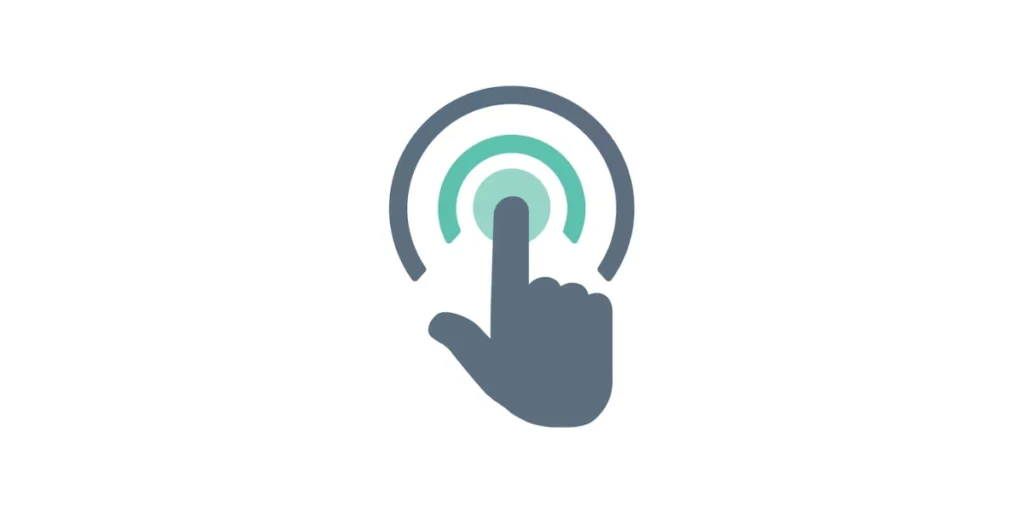
With an App Store QR Code, you just need to print a single QR Code on your print media promotions. And add an appropriate CTA such as—Scan here to download the app now!
In fact, it also helps you track the performance of your campaign. That means, how many people scanned your QR Code, where did they scan it, and exactly when did they scan it.
On top of this, it even offers event tracking. This means it helps you see how your end-users interact with the encoded content once they are done scanning the QR Code.
Such details help you monitor your campaign closely and enhance your future campaigns accordingly.
And this is possible because an App Store QR Code is dynamic in nature. A dynamic QR Code, once created, can be edited anytime you want. In fact, it even allows you to monitor its scanning activity.
This is unlike a static QR Code which, once created, cannot be edited. To edit it, you have to create a new QR Code altogether. Further, a static QR Code neither offers scan tracking nor event tracking.
F. Why to create QR Code for app link

Creating a QR Code for your app link can be a strategic and practical choice for a variety of reasons:
1. Ease of access
QR Codes provide a quick and convenient way for users to access and download your app. Scanning the code eliminates the need for manual typing and searching in app stores.
2. Improved user experience
Simplifying the process of downloading your app enhances the user experience. Users appreciate the convenience of scanning a QR Code to access your app.
3. Offline promotion
QR Codes can be included in offline marketing materials such as posters, flyers, business cards, brochures, and billboards. This allows you to promote your app effectively in the physical world.
4. Tracking and analytics
QR Code generators often come with tracking and analytics features. These tools enable you to monitor how many users have scanned the Code and, in some cases, even track conversions to app downloads.
5. Consistency and branding
Customizing the QR Code with your app’s logo and branding elements helps maintain brand consistency across various marketing materials.
6. Print and digital integration
QR Codes can be used across both print and digital marketing channels. This versatility ensures that you can reach a broader audience.
7. Targeted marketing
You can strategically place QR Codes in locations or on materials that target your specific audience. This makes it easier to connect with potential users.
8. Time and cost savings
By simplifying the user’s journey to download your app, you reduce the time and effort required for users to find and install it. This can lead to higher conversion rates.
9. Event marketing
QR Codes are valuable for event marketing. You can use them on event badges, banners, or promotional materials to encourage attendees to download your event-specific app.
10. Contactless transactions
In situations where you need to facilitate contactless transactions (e.g., ticketing, reservations, payments), QR Codes can link to the relevant app, streamlining the process.
11. Promotional campaigns
QR Codes can be incorporated into promotional campaigns. This allows you to track the success of different marketing initiatives and make data-driven decisions. This will work for QR Code link to app store and also for QR Code link to play store.
12. Feedback and reviews
Include QR Codes in your app for users to quickly access a review or feedback form. This can help boost your app’s rating and improve user engagement.
13. Social media engagement
QR Codes can also be used on social media to drive users to your app. For example, a QR Code in a social media post can take users to your app’s download page.
14. Adaptive marketing
If you have multiple versions or platforms of your app (e.g., iOS and Android), QR Codes can detect the user’s device and direct them to the appropriate app store.
15. Localized promotion
QR Codes can be used to promote your app in specific geographic areas or languages. This helps you to tailor your marketing to local audiences.
Generate a QR Code For Your Unique Case
START TODAY!
G. Who can use an App Store QR Code
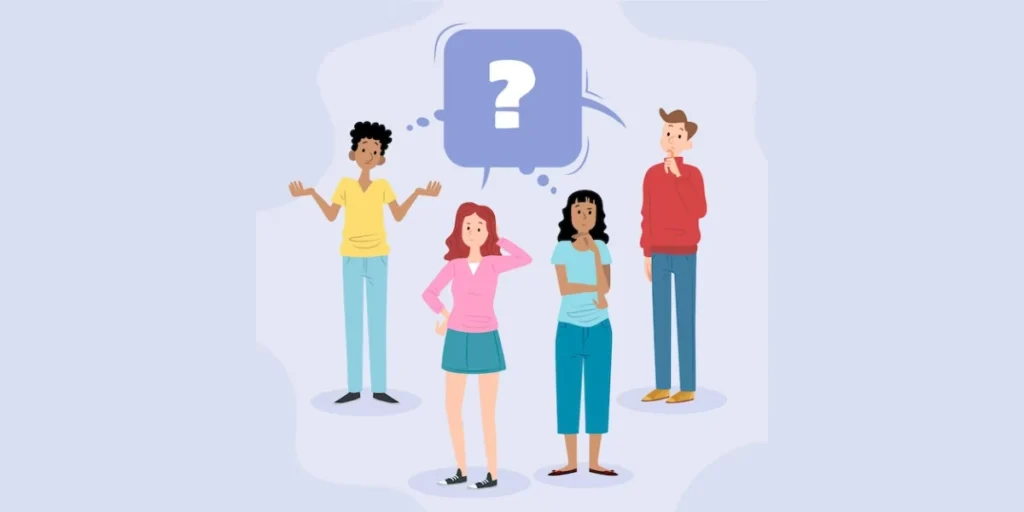
a. Gym and other fitness centers
Are you into the gym or fitness business and have a mobile app? It could be to help people book an appointment or even access your virtual fitness guide.
You’d want to get people to download your app. And App Store QR Code can help you do it easily. Just add it to posters inside your premises, on promotional material, even on your storefront. Don’t forget to add an appropriate instruction (CTA) with it. It could be—Scan here to Download our App.
People can then just scan the QR Code to install your app on their smartphones.
b. Retailers
Do you sell products via a mobile app? Then you’d certainly want as many people as possible to download your app. An App Store QR Code will come in handy to get people to install your app easily.
c. Financial institutions
Many financial institutions now have mobile apps to help customers avail the services easily. And an App Store QR Code goes a step ahead to help the customers install the app itself.
For example: Chase (trademark of JPMorgan Chase Bank) placed the QR Codes on the back of envelopes mailed to their clients. This QR Code prompted their clients to install the app with a simple scan.
d. SaaS tools
You probably know about SaaS tools. For the uninitiated, software as a service (or SaaS) is a way of delivering applications over the Internet. Many SaaS development companies are leveraging this QR Code technology. How? By getting web app users to download the mobile app.
For example, Confluence, a remote-friendly team workspace is promoting its mobile app via QR Codes. When scanned, it leads the end-user to their app according to the mobile’s operating system.
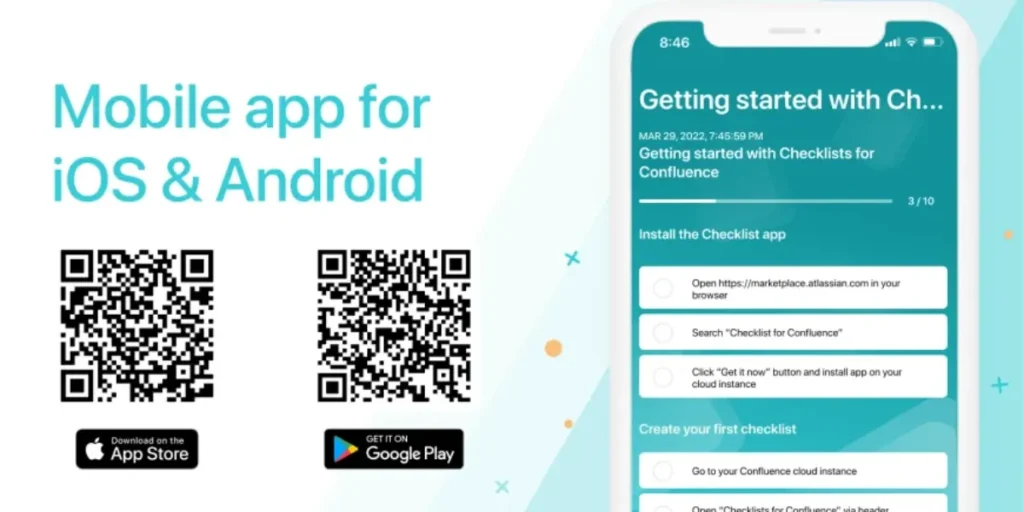
e. Government organizations
With modernization, many government bodies have turned towards technologies such as QR Codes. QR Codes are helping them offer detailed information to their citizens. Moreover, QR Codes are also being used to drive mobile app downloads. This is to help people easily avail of government’s services.
For example, Aarogya Setu, an Indian COVID–19 contact tracing digital app, is also using QR Codes to drive web traffic to its mobile app. This way, customers can easily avail of its services anytime and anywhere via their smartphones.
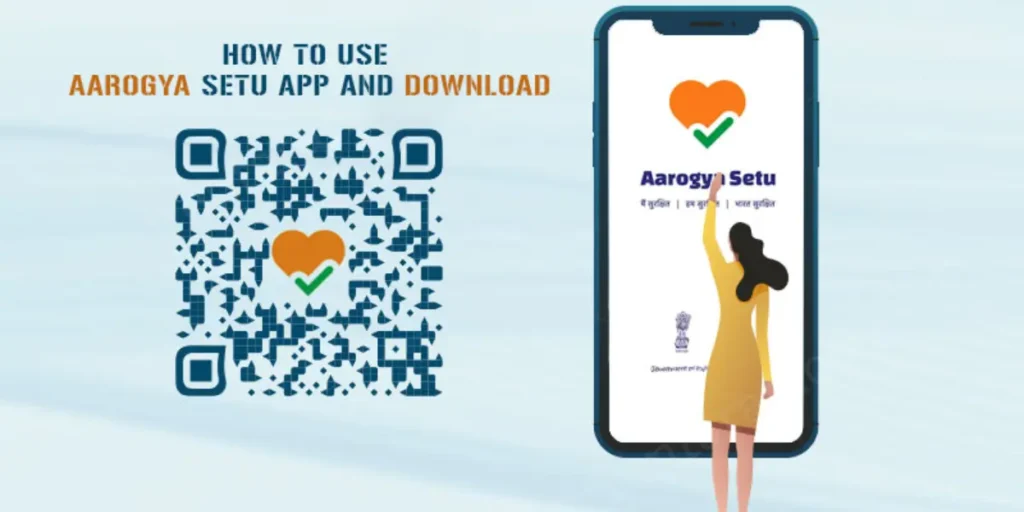
f. Tour guides
It is common for tour guides today to have a mobile app for the tourists. And a QR Code, again, can help the visitors install the app with a simple scan rather than tediously searching for the app on the app store.
H. How will the app store QR Code make a difference in your marketing
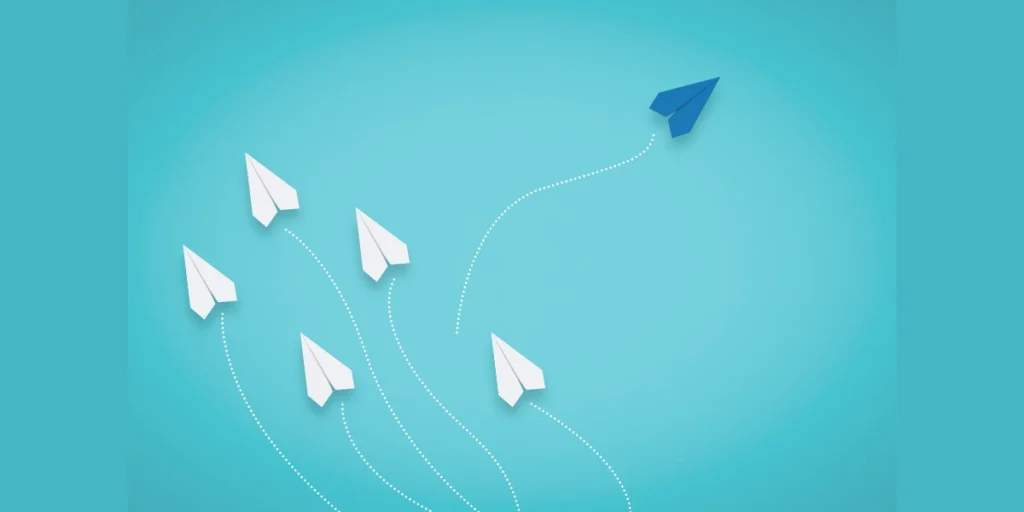
App Store QRs can significantly impact your marketing strategy by providing a convenient and efficient way for users to access and download your mobile app.
Here are some ways in which App Store QRs can impact your marketing efforts:
1. Quick access to app downloads
Users can simply scan the QR with their mobile devices, and it will directly lead them to the app’s download page on the respective app store (e.g., Apple App Store or Google Play Store).
You would not need a separate Play Store QR Code and an Apple Store QR Code.
This reduces friction and makes accessing your app easy for potential users.
2. Offline-to-online transition
QR Code to app store bridge the gap between offline and online marketing efforts. Whether you’re using QR on print materials, posters, business cards, or other physical items, users can seamlessly transition from the physical world to the digital app store environment.
3. Enhanced user experience
QRs streamline the user journey. Instead of asking users to remember the app name or search for it manually, they can simply scan the code for an instant link to the Play Store download page or the Apple App Store QR Code. This enhances the overall user experience and encourages quicker adoption.
Generate a QR Code For Your Unique Case
START TODAY!
4. Tracking and analytics
Scanova provides analytics, allowing you to track how many times the code has been scanned. This data can offer insights into the effectiveness of your offline marketing efforts and help you refine your strategy.
5. Promotional campaigns
Incorporating QRs into your promotional materials, such as brochures, banners, or event booths, can serve as a call to action that encourages users to explore your app immediately. This is particularly useful for time-sensitive promotions or events.
6. Cost-effective marketing
Using QRs is a cost-effective way to promote your app. You can include QRs on various marketing materials.
You can do this without the need for additional printed content or elaborate explanations, making it a simple and budget-friendly strategy.
7. Print and digital integration
QRs offer a seamless integration between traditional print media and digital channels. Whether in magazines, newspapers, or physical advertisements, users can easily transition from seeing an ad to engaging with your app.
8. Customizable and brandable
QRs can be customized through an app store QR Code generator to align with your brand’s aesthetics. You can incorporate your logo, brand colors, or other design elements, making them visually appealing and easily recognizable.
I. Real life use-cases of app store QR Code
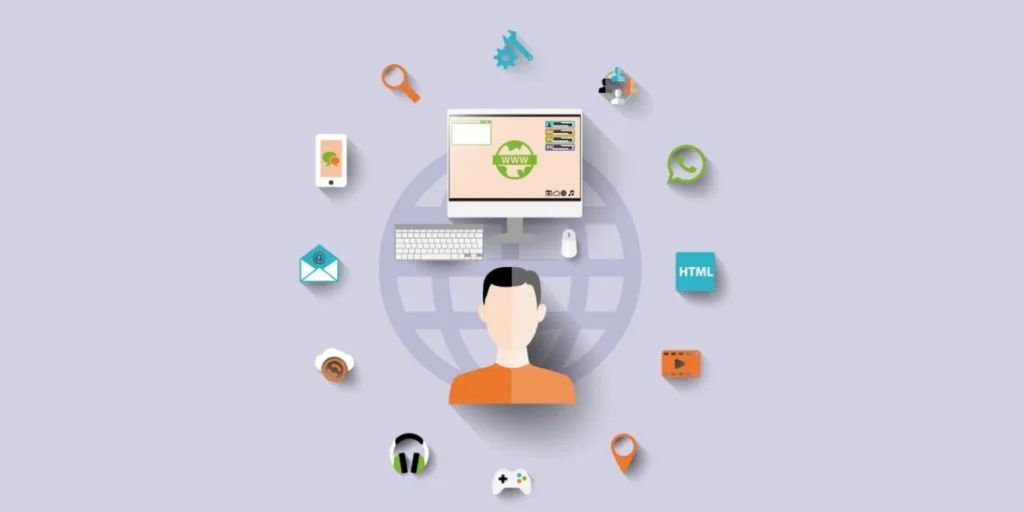
QR Code for app download can be used in various real-life scenarios to promote and facilitate the download of mobile applications. Some practical use cases include:
1. Marketing collaterals
Including QR Codes on printed marketing materials such as brochures, flyers, and posters can encourage potential users to quickly access and download the app.
2. Events and conferences
Placing QR Codes on event materials like badges, banners, and promotional items can help. Attendees easily download event-specific apps for schedules, networking, or interactive features.
3. Product packaging
Adding QR Codes to product packaging allows customers to access the app for additional information, customer support, or related products and services.
4. Business cards and signages
Including QR Codes on business cards and office signages can help potential clients or visitors quickly access your business’s app for more information or to get in touch.
5. In-store promotions
Using QR Codes in physical stores can help customers access the app for exclusive in-store offers, loyalty programs, or product information.
6. Digital advertisements
Incorporating QR Codes in digital ads, social media posts, or email marketing campaigns can drive users directly to the app store for easy installation and engagement.
7. Restaurant menus and food packaging
QR Codes on restaurant menus and food packaging can allow customers to quickly access the app for online ordering, reviews, or loyalty rewards.
8. Educational materials
Integrating QR Codes into educational materials such as textbooks or handouts can direct students to educational apps for interactive learning experiences or additional resources.
9. Transportation services
Placing QR Code to download app in public transportation hubs or vehicles can enable commuters to quickly access transportation apps for ticketing, schedules, or route information.
10. Hospitality services
Using QR Codes in hotels or hospitality establishments can allow guests to access apps for room service, hotel amenities, local attractions, or concierge services.
J. How to link QR Code to an app

1. Find a QR Code generator
To create QR Code for app, you will need an online QR Code generator that offers this category. Now there are many QR Code generators online. Will you compare all of them to find the best one for your use case?
It will need you to put a lot of time and effort to do the job. So, here is a detailed comparison chart of the top QR Code generators available online. You can go through the list to decide the best one for your use case and create QR Code online.
2. Create the QR Code
Using Scanova for a demo, here’s how you can create a QR Code for all app links:
1. Go to Scanova
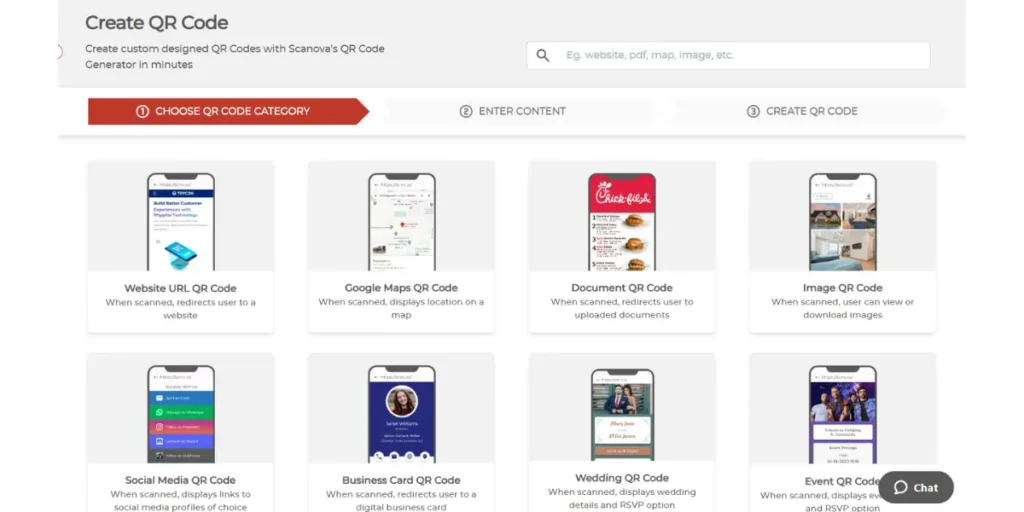
2. From QR Code categories, select App Store QR Code
3. Next, paste the app store links of your app in the appropriate fields
4. Once you enter all the links, click Continue
5. A window will appear prompting you to name the QR Code. After naming it, click Create QR Code
6. Next you will see the preview of the QR Code along with the Edit design option
7. If you click on the Edit design option, you’ll see two design options —Custom Logo and Custom Background. Custom logo design allows you to add a logo and colors to the QR Code. On the other hand, custom background design helps you add a background image to it
Note that if your use case is promotional, you must customize your QR Code. It acts as a point of engagement to attract 50%-200% more scans than a black-and-white QR Code.
7. Once you’re done designing the QR Code, click on Download
A window will open, prompting you to sign up for a 14-day free trial. Note that you’ll not have to enter your credit card details to sign-up.
8. A window will appear prompting you to specify the size and format of your QR Code image
Note that the app store QR Code should be of the right size to ensure good scanability. Here’s a detailed guide on how to calculate the ideal size of a QR Code for your use case.
10. Once you specify the details, click Export
That’s it. Your app store QR Code will be downloaded. It is always advisable to test scan the QR Code before putting it out.
K. How to edit App Store QR Code
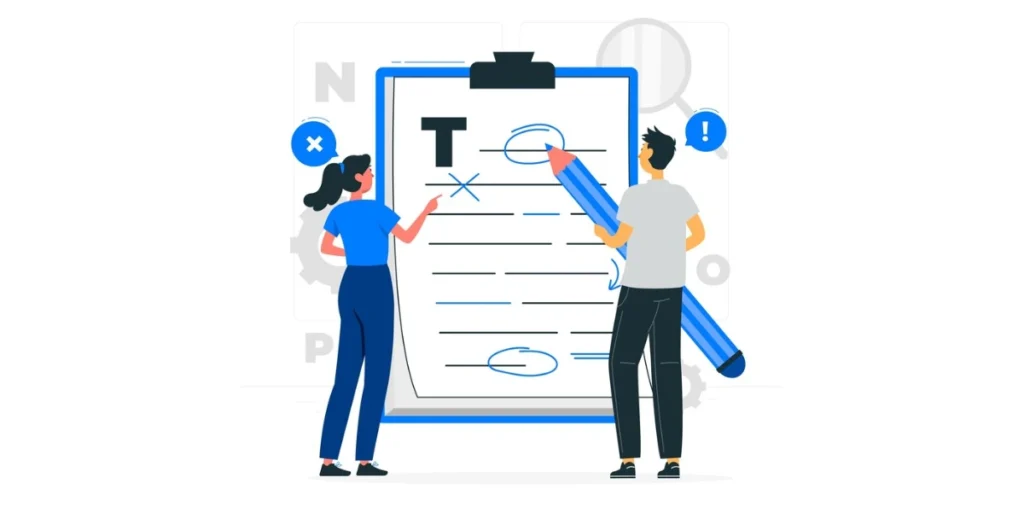
Say you created the QR Code with only Google Play app link. But after a few months, you decided to push the same app on the App Store too. And now you want to add the new link to the QR Code too.
App Store QR Code helps you do it easily. As mentioned earlier, an App Store QR Code is dynamic in nature and can be edited anytime you want. And still, the QR Code will remain the same. That means no need to create and print a new QR Code again.
Using Scanova QR Code generator, here is how you can do it:
1. Login to your Scanova account and go to My QR Codes
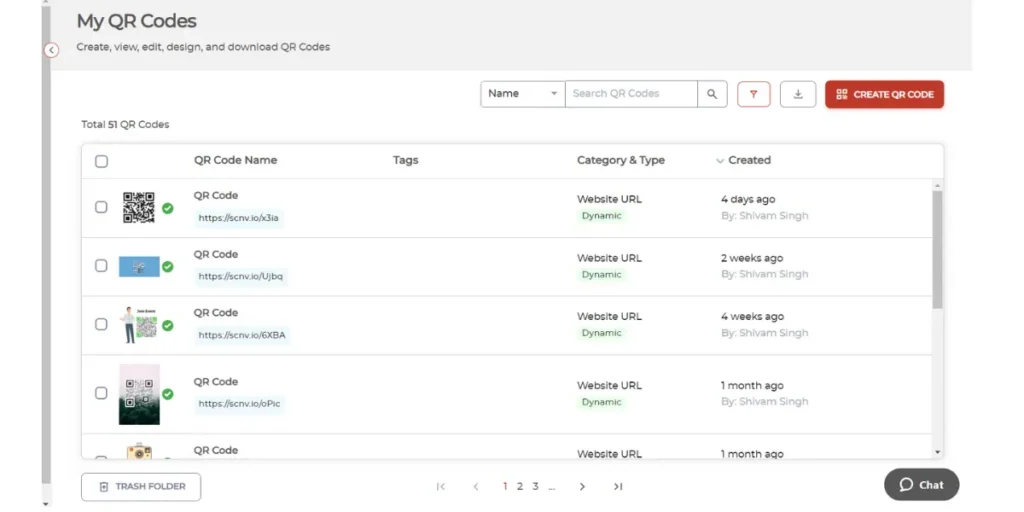
2. Select the QR Code you want to edit
3. Here you can edit the following things:
Content: You can edit the content you linked to a QR Code
Advance Settings: You can enable password protection, GPS location, lead generation, and even customize the short URL
Design: You can again edit the design in case you’d want to
4. Click on Update QR Code
That’s it. Your app store QR Code will be updated.
L. Best practices: App store QR Code
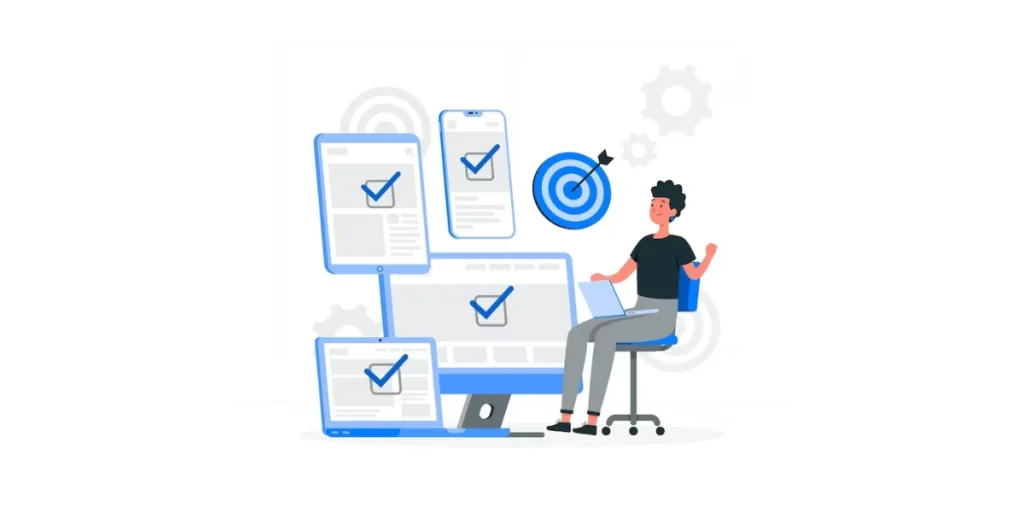
Creating an effective app store QR Code can help you promote your mobile application and make it easy for users to download it.
Here are some best practices for creating an app store QR Code:
1. Use a high-quality QR Code generator
Choose a reputable QR Code generator that allows you to create high-resolution app store QR Code. Make sure it provides tracking and analytics features so you can monitor the performance of your QR Code.
2. Customize the design
Customize the app store QR Code to match your app’s branding. You can add your app’s logo or use colors that are consistent with your app’s design.
3. Use the right content
The app store QR Code should link directly to your app’s download page on the respective app store, such as the Apple App Store or Google Play Store. Ensure that the URL is accurate and up to date.
4. Test the QR Code
Before printing or sharing the app store QR Code, test it to ensure it works correctly. Scan it with various QR Code scanner apps to verify that it directs users to the correct app store page.
5. Include a call to action
Alongside the app store QR Code, add a clear and concise call to action. For example, you can write “Scan to download our app” or something similar to encourage users to scan the code.
6. Consider placement
Where you place the app store QR Code matters. Make sure it’s easily visible and accessible to your target audience. Consider using your app store QR Code on marketing materials, posters, brochures, business cards, or in digital advertising.
7. Track and analyze usage
Use the tracking and analytics features provided by the QR Code generator to monitor how many people are scanning the code and whether they are converting to app downloads. This data can help you assess the effectiveness of your app store QR Code campaign.
8. Update as necessary
If you make changes to your app’s download link or branding, be sure to update the app store QR Code accordingly. Keeping it current is essential to avoid confusion.
9. Educate users
If you’re using an app store QR Code in a location where your target audience might not be familiar with them, consider adding a small note or instructions on how to scan the code.
10. Keep It simple
Don’t overcrowd the app store QR Code with too much information or overly complex designs. Simple, clean, and easily scannable app store QR Code tend to perform better.
11. Compliance with app store guidelines
Make sure your app store QR Code and accompanying marketing materials comply with the app store’s guidelines. This includes using accurate app icons, adhering to content guidelines, and avoiding misleading information.
12. A/B testing
You can create multiple versions of your app store QR Code with slight variations to see which one performs better. This can help you fine-tune your marketing efforts.
Generate a QR Code For Your Unique Case
START TODAY!
M. FAQs: QR Code to App Store
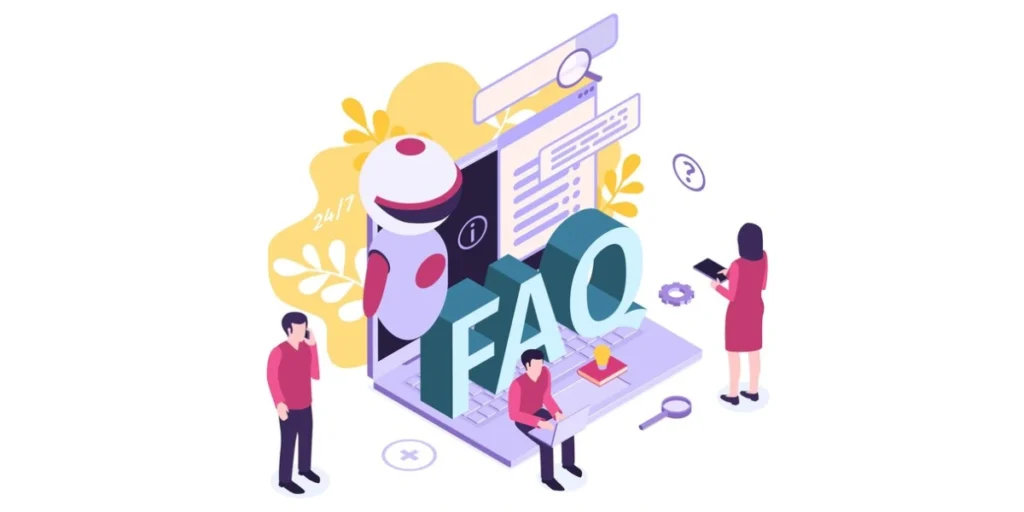
1. How to scan an app store QR Code?
Scanning an App Store QR is a simple process on both iOS and Android devices. On iOS, open the Camera app, position the QR in the frame, and tap the notification banner to access the associated link, usually directing you to the App Store for app download.
For Android, use the Camera app or Google Lens, align the QR within the frame, and follow the notification or information provided to access the link, typically leading to the Google Play Store for app installation.
Alternatively, third-party QR scanner apps can be downloaded, offering a dedicated scanning experience with similar steps to recognize and open App Store links.
2. How to create a QR Code for app download?
To create QR Code for app download, first, obtain the direct link to your app on the App Store.
Then, visit the Scanova website and choose the App Store link option. Input your app’s link, customize the QR Code’s appearance if desired, and generate the code.
Download the QR Code, ensuring high quality for optimal scanning. Test it to confirm the correct redirection to your app on the App Store.
Finally, incorporate the Scanova-generated QR Code into your marketing materials, such as posters or business cards, providing users with a convenient way to access and download your app.
3. How do I download an app from the Play Store using a QR Code?
To download an app from the Google Play Store using a QR Code, open your Android device’s Camera app, position the QR in the frame, and wait for automatic recognition.
Once detected, tap on the notification or pop-up, and your device will redirect to the app’s page on the Google Play Store. There, press the “Install” button, accept any required permissions, and wait for the app to download and install automatically.
This streamlined process offers a convenient way to access and install apps without the need for manual searches on the Play Store.
4. What app stores can I link to with an App Store QR Code?
An App Store QR code typically links directly to an app’s page on either Apple’s App Store for iOS devices or the Google Play Store for Android devices.
The choice between an “App Store QR Code” or a “Play Store QR Code” depends on the platform compatibility of the app.
5. Can a QR Code link to an app (Both app stores)?
Yes, a single QR can direct users to different app stores depending on the device used to scan the code (i.e. iPhone or an Android).
Summing Up
That’s all you need to know on how to make an app store QR Code. With an App Store QR Code, you can make your print promotions readily actionable. All that your audience need is—a smartphone to scan the QR Code and install the app.
